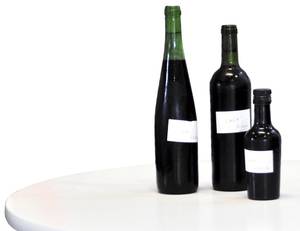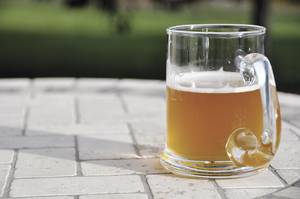Disenrich the offer
2014/03/01 Lakar Iraizoz, Oihane - Elhuyar Zientzia Iturria: Elhuyar aldizkaria

Caffeine to coffee, cream and alcohol at first beer, and recently to wine. It has been several years since the modified versions of the original products were launched, without the aforementioned components. Since then, manufacturers have been tuning their generation procedures, improving their flavors and textures. The new products that enter the market, such as non-alcoholic wine, have a great effort on the part of the researchers who will do so.
"Especially when one wants to eliminate a component, manufacturers have challenges to overcome to implement technological processes that can unbalance food - explains Matxalen Uriarte, head of the AZTI-Tecnalia New Food Area -. Because food is like networks, with many links. The removal or substitution of any of the elements of union of them, implies the interruption of a hole in the network, or, in case of pulling from it, a change in the aspect of the network. Incorporation into food means a change in the global structure of food that can affect taste, functional influence, etc. ". And of course, the ultimate goal is to remove or replace the desired component, but without modifying the sensory characteristics of the original product.
It occurs with coffee, for example. To obtain decaffeinated, the coffee vihis, a very soluble molecule in water, are extracted dissolved. "It is not the only water-soluble molecule," says Uriart-. Thus, when the caffeine is removed from coffee, some other compound is extracted as essential oils that give smell to coffee. That imbalance has to be rebuilt."
Caffeine out of water

Decaffeinated affects green coffee beans, which in most cases begin by moisturizing the beans to swell and thus increase the surface of each grain to extract caffeine.
Sometimes put the grains directly in hot water. They are given several bathrooms until getting the degree of decaffeinated desired. From this water, the caffeine extracted from the bihias is subsequently extracted, either through chemical solvents, such as methylene chloride and ethylene acetate, or by absorbers such as active carbon or ion exchanger resins. In other cases supercritical fluids (CO 2, generally) are used for the extraction of caffeine to green grains: Wet grains are subjected to a pressure of CO 2 to 200 atmospheres, conditions in which CO 2 behaves as gas and liquid. That is, it enters the grains as if it were gas and dissolves the caffeine as if it were liquid.
Once the caffeine extracted has been used in other products, to make drinks with caffeine, for example, the humidity is eliminated and the coffee is cooked and processed transformed as a conventional coffee. Decoffee procedures are highly implanted at the industrial level. Decaffeinated coffee takes a long time on the market. For example, the company Nescafé first launched it in Spain in 1961. The first procedure for the extraction of caffeine dates from 1903, invented by the German Ludwig Roselius.
Milk: playing with cream and lactose

Another product with a long history in the market is skimmed milk. In this case, "over the years, it has been possible to reconstruct the destructuring of sensory characteristics caused by overflow," said Uriarte. As he recalled, "at first it was impossible to match the sensory characteristics of this milk with the characteristics of conventional milk, it was like water. At present there are methods to act with the texture and, in general, to reconstruct the unbalanced network, that is, to maintain the original structure of milk, flavor and other components".
In the milk processing plants, the cream is removed from all the milk they receive and more or less is added depending on the product they wish to obtain. They do so to standardize the milk, so that all the milks that are put on sale (of each type of milk) have the same proportion of fat, regardless of the amount of cream that had in origin (between 2.6% and 6%). "It's very easy to skim milk," explains Iñaki Etaio, from the UPV Sensory Analysis Laboratory. They are extracted from milk by centrifugation, since it is a fat emulsion in an aqueous matrix, "which is easily destabilized".
Well, the skimming machines are overlapping cones at the base, from where, by passing the milk and turning the machine, they easily separate from the rest of the milk, due to their lower density. Finally, the resulting birth ratio is 0.04-0.07%.
Then the top layer is added again in greater or lesser proportion if the product to be obtained is skimmed, skimmed or whole milk. Yes, before adding them, they reduce the fatty blood cells because "they are much more stable. You can see clearly the stability of the blood cells in the bought milk: when boiling nothing occurs," added Etaio.
Another increasingly widespread product associated with milk is lactose-free milk. To remove lactose from milk are mainly used lactase enzymes from microorganisms that fragment the lactose molecule for the application of glucose and galactose. "This is the simplest and logical way to remove lactose," says Etaiok- from milk. Other more complex procedures could be, for example, the direct distribution of lactose from milk, as can be done in the laboratory, but it would be more expensive to do so at an industrial level."
One of the last in heartbreak, the wine
One of the final products derived from the elimination of a certain component of the original product is wine. But it is not the first alcoholic drink, alcohol-free beer has been on the market for years. Its alcoholic level is almost 0º (below 0.1%), while offering organoleptic characteristics similar to those of beer with alcohol. The wine continues to make that way. "In the case of beer, as the original alcohol level is lower, it is easier to remove alcohol, it is done in less steps and therefore loses less substances on the way," explains Uriarte.
In the case of wine, the de-alcoholization techniques are used for two purposes: on the one hand, to create a derivative of wine with the minimum alcohol possible and on the other, to reduce a little the wine graduation. The latter is the most sought after goal, for example, to fall from 14 to 11 degrees," explains Etaio. Thus, on the one hand, the level of alcohol of the wine is reduced and, on the other, the odorous substances are strengthened. Alcohol reduces the perception of certain odors, such as esters that produce fruit smell.

There are several methodologies to remove alcohol from the wine, one of them with the best results in flavor is the one that performs an inverse osmosis. At the base, pressing the liquid, they pass the wine through permeable membranes that only allow the passage of water and ethanol molecules. Thus, the original wine is divided into a hydroalcoholic solution containing water and alcohol that filter the membrane and other small molecules at very low concentrations, leaving all the other components of the wine in a dense and viscous liquid.
Then, this mixture of water and alcohol is distilled to distribute ethanol and water, and once distributed, water is added back to this concentrated solution. However, as Uriarte explained, "it has not yet been possible to eliminate 100% of alcohol by reverse osmosis, there is always something left, it is very difficult to go down below 0.5°. However, any drink containing less than 1% alcohol may be considered non-alcoholic."
There are many parameters and factors that intervene in this process, such as the number of times that the wine must pass from the membranes, the number of membranes to be used, the temperature to which it should be performed, and the volume of water with which the best filtration is obtained. "However, technology providers do not allow to give details about them for reasons of confidentiality," said Uriarte.
In fact, at AZTI-Tecnalia they collaborate with different technology suppliers for the production of alcohol-free wine in the commissioning of reverse osmosis equipment: "We're testing with the teams that are already used and making a series of changes in the process looking at how the final product is. We analyze all the steps of the process and observe which molecules have been lost and which remain depending on the physical-chemical profile of the wine, as well as the changes experienced in the sensory aspect by a team of experts. Thus, we can try to recover the lost characteristics by adding aromas, adding substances that provide texture or body (such as glycerin), etc. ".

Alcoholic without alcohol, different
And he stressed that the de-alcoholic wine changes over the original in four aspects. First, volatile aromatic substances that try to store themselves in the processes of alcohol elimination, but which to some extent are lost. Secondly, they lose the body; the feeling of fullness, the structure... is expressed by such indicators that they are reduced when the alcohol is removed, passing in part from wine to must. Thirdly, the balance between sweet taste and acid is lost, since alcohol provides some sweetness. If it is removed, the wine is much more acidic. And finally, dealcoholization influences the trigeminal sensations. They are called sensations not related to the taste: aridity, feeling of heat caused by alcohol, spicy, freshness, etc. "It mainly affects astringency; in non-alcoholic wines astringence is more evident - Etaiok- highlights. However, wines that choose to remove ethanol are usually low astringency to avoid it."
Research expects a derivative to be generated that distances itself as little as possible from the original product, "that the flavor is of the original product to the maximum possible level", says Uriarte. In short, both for wine and for any other product, we consume “because we like it. Everything can be what will lead us to choose for the first time in your favor, but if you don't make us pleasantly comfortable, of course, we don't consume them."

Gai honi buruzko eduki gehiago
Elhuyarrek garatutako teknologia




